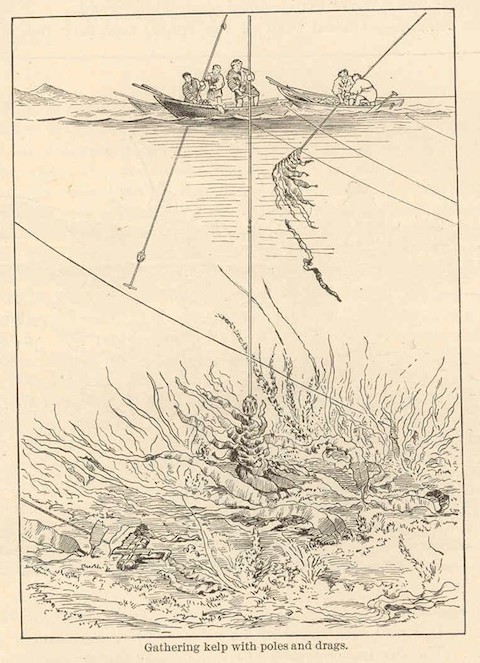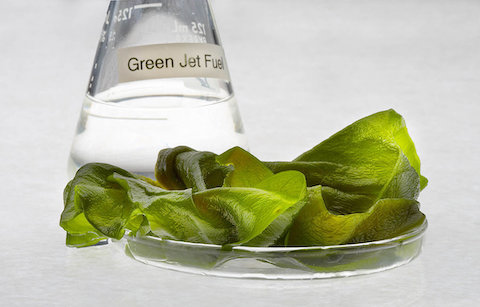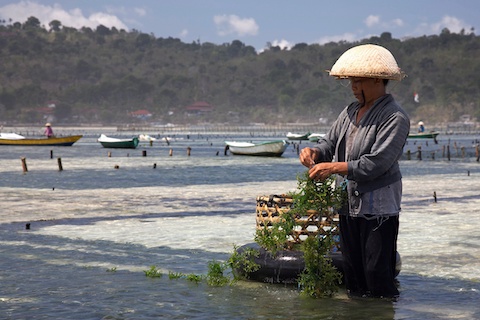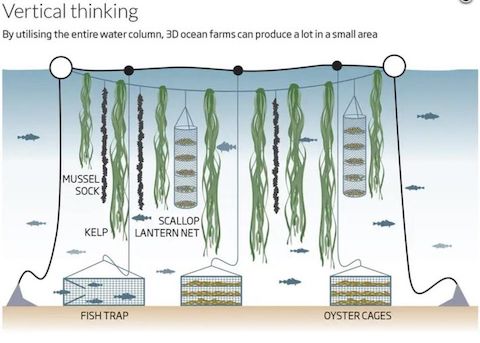
In another EarthDate, we talked about kelp: 100-foot-tall seaweed that grows near shore.
Asian cultures have farmed kelp and other large seaweeds for centuries. If you’ve had Japanese food, you’ve probably eaten it sliced in seaweed salad, dried to flavor soup, or wrapped around sushi.
Seaweed is nutritious, easy to grow and harvest, and requires no irrigation or fertilizer.
It thrives in cool- and cold-water bays, including those that have become barren from overfishing, mismanagement, or agricultural runoff.
These many qualities have encouraged a new generation of seaweed farmers, often former commercial fisherman. They’re creating new vertical seaweed farms in places like the North Atlantic and the Pacific Northwest.
Farmers attach seaweed spores to ropes, then anchor them to the bottom. As the seaweed grows, it takes in carbon dioxide and recharges the water with oxygen, making it ideal for mollusks.
So farmers also grow oysters, scallops, and mussels with the seaweed. Each acre of vertical farm can produce up to 10 tons of kelp and a quarter million bivalves per year.
Researchers have calculated that farming an area the size of Washington state could produce all the food the worlds’ human population needs.
Of course, few of us would want to eat just kelp and oysters. But vertical ocean farms can employ out-of-work fisherman and revitalize ocean environments, all while producing food—a sustainable aquaculture that’s a win-win all the way around.
Background
Synopsis: Ocean farming is a multidimensional good news story. A centuries-old practice in Asia, it is now becoming popular and more technologically advanced in other regions. Early rope-and-net seaweed farms have evolved into biodiverse vertical farms that produce a variety of highly nutritious seaweeds and shellfish, serve as efficient carbon sinks, and provide robust outdoor livelihoods in coastal settings. Ocean farming is sustainability in action.
- There are many types of highly nutritious edible seaweed in Earth’s oceans, most of which are red, green, or brown macroalgae. You have probably consumed seaweed.
- There are more than 10,000 species of macroalgae with a range of fresh, distinctive flavors.
- In a previous EarthDate episode, we talked about a brown macroalgae called kelp (Laminariales) that grows as submerged nearshore kelp forests. Fresh kelp may be sliced and eaten in salads and soups. When dried, it is known as kombu (Japanese) or haidai (Chinese).
- Nori, a red macroalgae, is made into paper-like sheets and used to wrap sushi rolls. Other red algaes are used to make agar for use in laboratory petri dishes.
- Macroalgae are used in medicines, wound dressings, cosmetics, toothpaste, and as an emulsifier in foods like ice cream and salad dressing.

- Humans have farmed Earth’s oceans for these “sea vegetables” for centuries, especially in east and southeast Asia.
- Early seaweed farmers developed specialized tools for harvesting wild seaweed.
- Active seaweed cultivation began in Tokyo Bay as early as 1670. Farmers used bamboo branches to collect seaweed spores, then moved them to nutrient-rich river estuaries to foster rapid growth.
- Soon farmers learned to seed the spores onto ropes or nets suspended in the water column for easier harvesting.

- Seaweed farming has expanded globally since 2000 because of its positive impact on marine ecosystems and communities.
- Ocean farming doesn’t require land, fresh water, fertilizer, or pesticides. The ocean provides all that for the farmer.
- During photosynthesis, macroalgae sequesters carbon in its fast-growing fronds, consuming carbon dioxide, nitrogen, phosphorous, and other nutrients while it deacidifies and reoxygenates the water column. This can be a boon for areas suffering from agricultural runoff that may create inhospitable acidic and hypoxic dead zones.
- In turn, harvested seaweed can be used as agricultural fertilizer for land crops, resulting in organic runoff that fertilizes coastal macroalgae beds, creating a sustainable cycle.
- Shellfish farmed near seaweed beds develop thicker shells and sweeter, larger meat in the macroalgae-freshened environment, so ocean farmers increase the biodiversity of their plots by adding cash crops of various shellfish.
- Vertical or 3D farming is a concept that combines these synergistic benefits into an amazingly compact, productive, sustainable ocean farm.
- Typically leased in state waters, 3D farms are barely noticeable from the sea surface, marked by a few buoys and held in place by hurricane-proof anchors.
- Ocean farmers grow kelp and other seaweed on ropes that are supported a few feet below the surface by the buoys.
- Mussels are also seeded on ropes, while baskets of scallops hang in nets suspended alongside the macroalgae.
- Oysters grow in cages on the seafloor below the suspended crops.
- The anchored networks of rope dampen waves and storm surges, creating a protected habitat for marine life, so fish traps are often prolific for farmers.
- A key piece of this sustainability story is that many emerging vertical farms are small local coastal businesses that are owned by and employ hundreds of former commercial fishermen in the United States, Canada, and Europe.
- Sustainable ocean farming is helping to keep coastal communities alive as commercial fishing stocks are challenged and fleets are mothballed along with antiquated and highly destructive fishing practices.
- Former commercial fisherman Bren Smith’s talks about his voyage into 3D ocean farming in his inspirational TEDxBermuda Talk. His GreenWave 3D Ocean Farm Development Program won the 2015 Buckminster Fuller Challenge, and in 2017 Smith was named one of RollingStone Magazine’s 25 People Shaping the Future.
- Smith redesigned the infrastructure necessary for small ocean farms and made the design of his own farm replicable and accessible to new farmers, requiring minimal capital investment. He provides training and has secured guarantees to purchase 80% of crops for farmers in his network over their first five years.
- Many ocean farms are family businesses that are optimized at 20 acres or less.
- And it is good business: each acre of a vertical farm can produce up to 10 tons of kelp and 250,000 bivalves per year, while their crops of “sea vegetables” freshen the water and sequester carbon.

- This remarkable productivity has led to estimates that suggest ocean farming an area the size of Washington state could feed the world while sequestering carbon.
- Recent studies suggest that more than 18.5 million square miles of Earth’s oceans—260 times the area of Washington state—are suitable for seaweed farming.
- Seaweed is consumed in east and southeast Asia, southern Africa, South America, Scandinavia, Canada, and the United Kingdom, and it is gaining popularity in the United States.
- Today’s top global seaweed producers are China, France, the United Kingdom Japan, and Chile.

